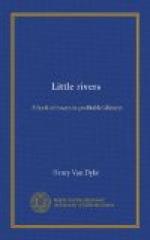“Thoughts that do often lie too deep for tears.”
She has her own scale of values for these mementos, and knows nothing of the market price of precious stones or the costly splendour of rare orchids. The thing that pleases her is the thing that she will hold fast. And yet I do not doubt that the most important things are always the best remembered; only we must learn that the real importance of what we see and hear in the world is to be measured at last by its meaning, its significance, its intimacy with the heart of our heart and the life of our life. And when we find a little token of the past very safely and imperishably kept among our recollections, we must believe that memory has made no mistake. It is because that little thing has entered into our experience most deeply, that it stays with us and we cannot lose it.
You have half forgotten many a famous scene that you travelled far to look upon. You cannot clearly recall the sublime peak of Mont Blanc, the roaring curve of Niagara, the vast dome of St. Peter’s. The music of Patti’s crystalline voice has left no distinct echo in your remembrance, and the blossoming of the century-plant is dimmer than the shadow of a dream. But there is a nameless valley among the hills where you can still trace every curve of the stream, and see the foam-bells floating on the pool below the bridge, and the long moss wavering in the current. There is a rustic song of a girl passing through the fields at sunset, that still repeats its far-off cadence in your listening ears. There is a small flower trembling on its stem in some hidden nook beneath the open sky, that never withers through all the changing years; the wind passes over it, but it is not gone—it abides forever in your soul, an amaranthine blossom of beauty and truth.
White heather is not an easy flower to find. You may look for it among the highlands for a day without success. And when it is discovered, there is little outward charm to commend it. It lacks the grace of the dainty bells that hang so abundantly from the Erica Tetralix, and the pink glow of the innumerable blossoms of the common heather. But then it is a symbol. It is the Scotch Edelweiss. It means sincere affection, and unselfish love, and tender wishes as pure as prayers. I shall always remember the evening when I found the white heather on the moorland above Glen Ericht. Or, rather, it was not I that found it (for I have little luck in the discovery of good omens, and have never plucked a four-leaved clover in my life), but my companion, the gentle Mistress of the Glen, whose hair was as white as the tiny blossoms, and yet whose eyes were far quicker than mine to see and name every flower that bloomed in those lofty, widespread fields.
Ericht Water is formed by the marriage of two streams, one flowing out of Strath Ardle and the other descending from Cairn Gowar through the long, lonely Pass of Glenshee. The Ericht begins at the bridge of Cally, and its placid, beautiful glen, unmarred by railway or factory, reaches almost down to Blairgowrie. On the southern bank, but far above the water, runs the high road to Braemar and the Linn of Dee. On the other side of the river, nestling among the trees, is the low white manor-house,




